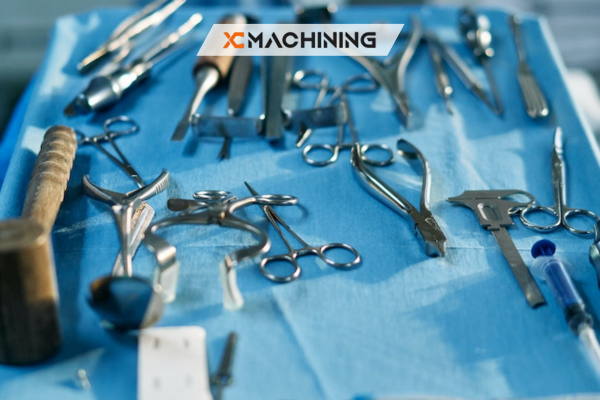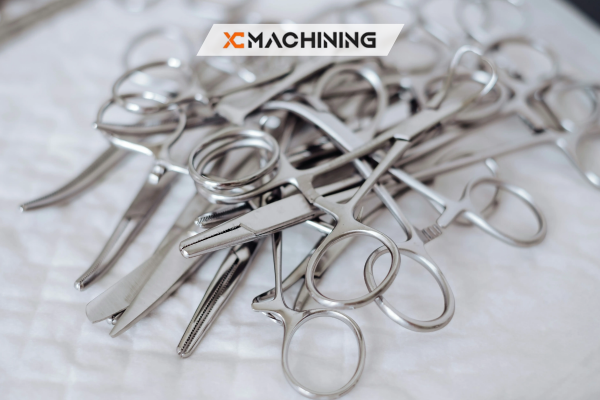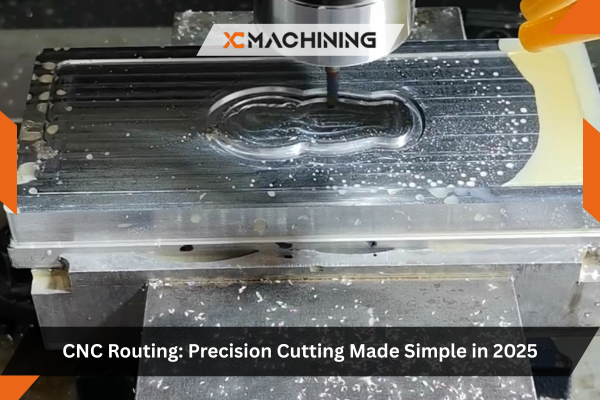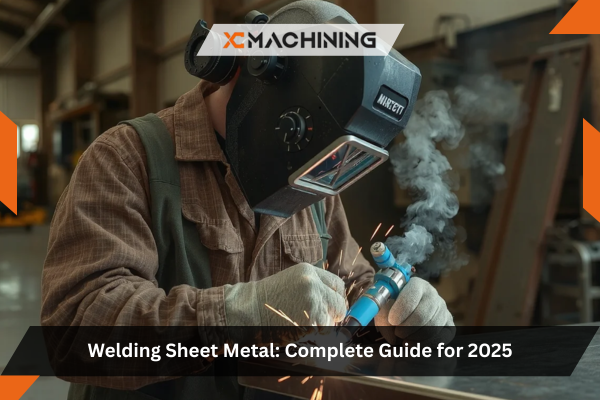Meta Description: See how medical CNC machining services craft safe implants precision, compliance, and insights on top provider XC Machining plus future-proof tips for engineers.
Needle-fine bone screws, polished hip cups, and stent frames thinner than a strand of hair all rely on medical CNC machining services. If tolerances drift or finishes roughen, a surgeon’s steady hand is wasted and the patient pays the price. You want parts that fit first time, glide through sterilizers, and never corrode inside the body. Team up with tight-tolerance shops XC Machining, Protolabs, Xometry, Fictiv, and Jabil for:
- Micron-level accuracy
- FDA-ready materials
- Same-week prototypes
- Full traceability
- Scalable production
We’ll explore why accuracy matters, break down workflows, compare providers, and flag future tech so you can choose medical CNC machining services with total confidence.
Medical CNC Machining Services: Patient Safety
Precision means more than bragging rights; it decides whether a heart valve closes cleanly or leaks. Medical CNC machining services pair digital twins with climate-controlled cells to keep steel from swelling, cutters from chattering, and edges from burrs. Temperature probes, laser tool setters, and in-cycle probing form a feedback loop that slashes scrap. A single micron one-seventieth of a hair can be the difference between smooth bone fusion and revision surgery. No wonder hospitals quiz vendors on gauges, not slogans.
Micron-Level Tolerance
Holding ±0.005 mm sounds sci-fi, yet modern spindles glide on air bearings while glass-scale encoders read nanosteps. This “Precision CNC machining for medical devices” culture keeps drill bits perfectly aligned with pre-op CT scans, stopping surgeons from reaming bone twice.
Implant-Ready Finishes
Ra 0.2 µm surfaces stop bacteria from clinging. Shops achieve that with diamond slurry passes, then ultrasonic-clean parts destined for “CNC machining for medical equipment” so hospitals open sterile trays, not question marks.
Traceability & Compliance
Every lot tag, coolant change, and torque spec logs into an e-QMS. Regulators can rewind time if a complaint arises—just another perk of “Custom CNC machining for healthcare” that generic job shops rarely match.
Provider Spotlight
XC Machining has climbed to the front of the medical CNC machining company pack by pairing Swiss lathes with live video QA dashboards. Upload a STEP file before lunch, and a DFM report pings back before coffee cools. Protolabs thrills prototype teams with overnight deliveries, Xometry crowdsources capacity across continents, Fictiv excels at titanium micro-parts, while Jabil tackles million-unit drug-pump housings. Each outfit lives and breathes “Precision CNC machining for medical devices,” yet their sweet-spot volumes and material menus vary. Match your order size, alloy, and audit depth to the provider’s strongest lane, and you’ll dodge rush fees and rework pain.
Material Choices Inside The Operating Room
Titanium bonds to bone; cobalt-chrome shrugs off joint loads; PEEK hides from X-rays. Medical CNC machining services must know when to pick which. XC Machining stocks dozens of ISO-qualified bar sizes, slicing lead time. They temper stainless to kill ferrous contamination, an edge over any less seasoned medical CNC machining company. Meanwhile, “CNC machining for medical equipment” often pairs metal frames with polymer housings—mixed-material assemblies that demand fixturing finesse. Always ask for sample coupons passivated and electropolished to your exact spec.

From CAD To Cutting: Digital Workflow Explained
It starts with a surgeon’s sketch and ends in a sterile pouch. CAM software simulates every toolpath, flagging overhangs unfit for “Precision CNC machining for medical devices.” Post-processors then translate code to five-axis mills. On-machine probing zeroes fixtured blanks within three microns; probing again mid-cycle ensures drift stays invisible. XC Machining streams live SPC charts so engineers see CpK stats in real time—transparency few rivals offer. This tight loop is why medical CNC machining services can promise first-article approval on the very first try.
Info: A 30-second CAM tweak can save 3 hours of deburr time—always review simulation videos.
Quality Control—Beyond The Microscope
Optical comparators used to be enough; not today. CMM arms trace complex surfaces, CT scanners peek inside lattice implants, and blue-light scanners map whole geometries in seconds. Each device syncs to the shop’s MES, feeding dashboards that shout if gauges creep. Such rigor lets “CNC machining for medical equipment” meet ISO 13485 easiest. XC Machining’s lab even runs salt-spray tests before shipping stainless trays—one step past the minimum. That diligence cements their reputation as a gold-standard medical CNC machining company.
Fact: CT scanning spots 0.02 mm voids invisible to surface probes.
Scaling Up: High-Volume Implants Without Quality Slip
Prototyping ten spinal cages is cute; molding two hundred thousand infusion-pump heads per quarter separates amateurs from experts. Medical CNC machining services ramp smoothly by designing modular fixtures and stocking duplicate cutters. Lights-out robot cells feed bar stock all weekend. XC Machining labels each pallet with RFID chips, so traceability follows parts through anodizing, cleaning, and packaging. “Custom CNC machining for healthcare” at volume demands predictive maintenance; a spindle vibration spike triggers auto-scheduling, not surprise downtime.
| Material | Typical Implant | Annual Volume | Primary Finish |
| Ti-6Al-4V | Bone plates | 100 000 | Passivation |
| 316L SS | Surgical clamps | 250 000 | Electropolish |
| PEEK | Spinal cages | 50 000 | Plasma etch |
| CoCr | Knee joints | 80 000 | Mirror polish |
Advanced Tech: 5-Axis, Swiss, And Add-On Sensors
Five-axis mills cut compound-angle ports in one go; Swiss lathes churn slender bone screws without whip. XC Machining integrates in-spindle probes reading chips mid-flight vital for “CNC machining for medical equipment” with blind internal geometries. Air-knife coolant clears swarf; eddy-current sensors flag tool wear in-cycle. All these gadgets shrink error budgets, proving that high-end gear plus trained eyes still trump cheapest-per-hour solutions.
Quick Tip: If a quote lacks tool-life data, the shop probably wings it—buyer beware.
Surface Treatments And Sterilization Know-How
Anodize, passivate, electropolish, PVD each adds protection or biocompatibility. Medical CNC machining services must time finish so no oxide blooms on shelves. Vacuum ovens bake out hydrogen, preventing embrittlement in titanium springs, a trick lesser shops skip. “Custom CNC machining for healthcare” also means labeling parts laser-darkened but burr-free so nurses can read them after 2 000 autoclave cycles.
Danger: Mixing passivation chemistries on the same line risks galvanic spots—segregate tanks.
Regulations And Documentation—Your Audit Lifeline
The FDA, MDR, and ISO 13485 share one fear: unknown variables. Medical CNC machining services fight that with device history records holding every calibration, gauge R&R, and material cert. XC Machining signs electronic batch travelers so auditors trace issues in minutes. Want UDI barcodes etched at the machine? Easy. This obsession with paperwork distinguishes a genuine “medical CNC machining company” from any hobbyist mill down the street.
Cost Optimization Without Cutting Corners
Precision is pricey, but hidden gains offset quotes. Designing for fixturing reduces setups; picking standard bar diameters trims scrap. Engineers hold free DFM clinics, showing clients how “Precision CNC machining for medical devices” can shave costs by chamfering instead of radiusing non-load edges. Bulk buys of titanium bars and shared tool libraries spread overhead across programs, keeping CFOs happy without risking patient safety.
Suggestion: Submit three design variants; sometimes a 0.2 mm tweak halves cycle time.
Future Trends—Smarter, Smaller, Safer
Micro-mills now cut stent struts 50 µm thick, while AI monitors tool wear and predicts failures hours early. Hybrid machines print near-net shapes, then finish-cut in a single clamp. The pilots real-time surface-roughness sensors that whisper to CAM software mid-cycle. For “CNC machining for medical equipment,” expect more titanium-magnesium alloys that biodegrade after healing, reducing second surgeries. Staying close to an innovative medical CNC machining company ensures your devices ride the next wave, not chase it.
Warnings: Novel alloys often need new validation—budget at least six months for tests.

Conclusion
At the end of the day, lives hinge on how well medical CNC machining services turn digital dreams into stainless reality. Choose providers like XC Machining who marry steady spindles, spotless quality data, and regulatory fluency. Trust shops steeped in “Precision CNC machining for medical devices,” fluent in “CNC machining for medical equipment,” masters of “Custom CNC machining for healthcare,” and proud to be a leading medical CNC machining company. Do that, and every bone screw, catheter tip, or robotic gripper will slide perfectly into place, helping patients heal faster and letting engineers sleep soundly.
FAQ
What certificates should I ask for?
ISO 13485, material mill certs, and full device history records are the big three.
Can I supply my own material?
Yes, but the billet needs traceable heat-lot paperwork and arrives in sealed crates.
Does cnc beat 3d printing for implants?
For metal strength and mirror finishes, CNC still wins on surface integrity.How many sterilization cycles will anodized parts survive?
Type II titanium anodize routinely endures over 2 000 steam cycles without fade.





